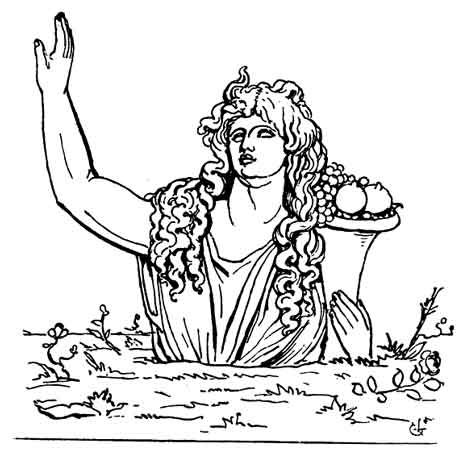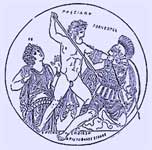
Gaia, drawing based on the Pergamon Zeus Altar
Gaia ("land" or "earth", from the Greek Γαία; variant spelling Gaeasee also also Ge from Γη) is a Greek goddess personifying the Earth.
In Greek mythology
Hesiod's Theogony (116ff) tells how, after Chaos, arose broad-breasted Gaia the everlasting foundation of the gods of Olympus. She brought forth Uranus (or Ouranos), the starry sky, her equal, to cover her, the hills, and the fruitless deep of the Sea, Pontus, "without sweet union of love," out of her own self. But afterwards, Hesiod tells, she lay with Heaven and bore the World-Ocean Oceanus, Coeus and Crius and the Titans Hyperion and Iapetus, Theia and Rhea, Themis and Mnemosyne and Phoebe of the golden crown and lovely Tethys. "After them was born Cronos the wily, youngest and most terrible of her children, and he hated his lusty sire."
Hesiod mentions Gaia's further offspring conceived with Uranus, first the giant one-eyed Cyclopes, builders of walls, later assigned individual names: Brontes ("thunderer"), Steropes ("lightning") and the "bright" Arges: "Strength and might and craft were in their works." Then he adds the three terrible hundred-handed sons of Earth and Heaven, the Hecatonchires: Cottus and Briareos and Gyges, each with fifty heads.
Uranus hid the Hecatonchires and the Cyclopes in Tartarus so that they would not see the light, rejoicing in this evil doing. This caused pain to Gaia (Tartarus was her bowels) so she created grey flint (or adamantine) and shaped a great flint sickle, gathering together Cronus and his brothers to ask them to obey her. Only Cronos, the youngest, had the daring to take the flint sickle she made, and castrate his father as he approached Gaia to have sex with her. And from the drops of blood and semen, Gaia brought forth still more progeny, the strong Erinyes and the armoured Gigantes and the ash-tree Nymphs called the Meliae. From the testicles of Uranus in the sea came forth Aphrodite. For this, a Greek etymologist urged, Uranus called his sons "Titans," meaning "strainers" for they strained and did presumptuously a fearful deed, for which vengeance would come afterwards; for, as Uranus had been deposed by his son Cronus, so was Cronus destined to be overthrown by Zeus his son that Rhea his sister-wife bore him. In the meantime, the Titans released the Cyclopes from Tartarus, and Cronus was awarded the kingship among them, in a Golden Age
After Uranus' castration, Gaia gave birth to Echidna and (sometimes) Typhon by Tartarus. By Pontus, Gaia birthed the sea-deities Nereus, Thaumas, Phorcys, Ceto and Eurybia.
Zeus hid Elara, one of his lovers, from Hera by hiding her under the earth. His son by Elara, the giant Tityas, is therefore sometimes said to be a son of Gaia, the earth goddess, and Elara.
Gaia also made Aristaeus immortal.
Gaia is believed by some sources (Joseph Fontenrose 1959 and others) to be the original deity behind the Oracle at Delphi. She passed her powers on to, depending on the source, Poseidon, Apollo or Themis. Apollo is the best-known as the oracle power behind Delphi, long established by the time of Homer, having killed Gaia's child Python there and usurped the chthonic power. Hera punished Apollo for this by sending him to King Admetus as a shepherd for nine years.
Unlike Zeus, a roving nomad god of the open sky, Gaia was manifest in enclosed spaces: the house, the courtyard, the womb, the cave. Her sacred animals are the serpent, the lunar bull, the pig, and bees. In her hand the narcotic poppy may be transmuted to a pomegranate.

Gaea (or Gaia) gives Erichthonius to Athena in the presence of Kekrops (or Cecrops)

Erichthonius Staatliche Antikensammlungen 2413
Family tree
Parthenogenesis (Uranus , Pontus )
Elara (Tityas)
Pontus (Ceto , Eurybia , Phorcys , Nereus , Thaumas)
Uranus (Cyclopes : Arges , Brontes, Steropes, Hecatonchires : Briareus , Cottus , Gyes, Titans : Coeus ,Crius , Cronus, Hyperion, Iapetus ,Mnemosyne , Phoebe , Rhea ,Tethys , Theia, Themis)
Hephaestus (Erichthonius of Athens )
Unknown father (Mimas , Pheme , Python )

Gaia (Ge), Poseidon against the giant Polybotes
Inscription of the Artists: Erginos epoiesen, Aristophanes egraphe.
Interpretations
Some sources, such as authors Marijas Gimbutas and Barbara Walker, claim that Gaia as the Mother Earth is a later form of a pre-Indo-European Great Mother who had been venerated in Neolithic times, but this point is controversial in the academic community. Belief in a nurturing Earth Mother is a feature of modern Neopagan "Goddess" worship, which is typically linked by practitioners of this religion to the Neolithic goddess theory. For more information, see the article Goddess.
Hesiod's separation of Rhea from Gaia was not rigorously followed, even by the Greek mythographers themselves. Modern mythographers like Karl Kerenyi or Carl A. P. Ruck and Danny Staples, as well as an earlier generation influenced by Frazer's The Golden Bough, interpret the goddesses Demeter the "mother," Persephone the "daughter" and Hecate the "crone," as understood by the Greeks, to be three aspects of a former Great Goddess, who could be identified as Rhea or as Gaia herself. In Anatolia (modern Turkey), Rhea was known as Cybele. The Greeks never forgot that the Mountain Mother's ancient home was Crete, where a figure some identified with Gaia had been worshipped as Potnia Theron (the "Mistress of the Animals") or simply Potnia ("Mistress"), an appellation that could be applied in later Greek texts to Demeter, Artemis or Athena.
In Rome the imported goddess Cybele was venerated as Magna Mater, the "Great Mother" and identified with Roman Ceres, the grain goddess who was an approximate counterpart of Greek Demeter, but with differing aspects and venerated with a different cult.
In other cultures
The idea that the fertile earth itself is female, nurturing mankind, was not limited to the Mediterranean. In Norse mythology the Great Mother, the mother of Thor himself, was known as Jord, Hlódyn, or Fjörgyn. In Lithuanian mythology Gaia - Žemė is daughter of Sun and Moon. Also she is wife of Dangus (Varuna). In Pacific cultures, the Earth Mother was known under as many names and with as many attributes as cultures who revered her for example Maori whose creation myth included Papatuanuku, partner to Ranginui - the Sky Father.
In modern ecological theory
The mythological name was revived in 1969 by James Lovelock for his Gaia hypothesis, which was later developed by Lynn Margulis into a Gaia theory. The hypothesis proposes that living organisms and inorganic material are part of a dynamic system that shapes the Earth's biosphere. Earth itself is viewed as an organism with self-regulatory functions.
In popular culture
The theme behind the movie Final Fantasy: The Spirits Within adapts Lovelock's philosophy of Gaia, which is also embraced within parts of the New Age movement, and by some environmentalists.
In the game Werewolf: The Apocalypse, werewolves are supposed to be Gaia's weapons against the Wyrm, a representation of ecological destruction.
The cartoon series Captain Planet and the Planeteers features a personification of Gaia, whose well-being is dependent on the stae of the environment worldwide.
References
Joseph Fontenrose, Python: A Study of Delphic Myth and its Origins, Berkeley: University of California Press, 1959; reprint 1980
Gods of the Greeks, Carl Kerenyi
Carl A.P. Ruck and Danny Staples, The World of Classical Myth, 1994.
Floor fresco from Qasr al-Hayr al-Gharbi, Syria, Scene: Gaea and Centaurs of the Sea , Arab painter around 730
| Chthonic deities |
| Hades and Persephone, |
| Gaia, Demeter, Hecate, |
| Iacchus, Trophonius, |
| Triptolemus, Erinyes |
| Heroes and the Dead |
See also : Greek Mythology. Paintings, Drawings
A - B - C - D - E - F - G - H - I - J - K - L - M -
N - O - P - Q - R - S - T - U - V - W - X - Y - Z
Α - Β - Γ - Δ - Ε - Ζ - Η - Θ - Ι - Κ - Λ - Μ -
Ν - Ξ - Ο - Π - Ρ - Σ - Τ - Υ - Φ - Χ - Ψ - Ω
Retrieved from "http://en.wikipedia.org/"
All text is available under the terms of the GNU Free Documentation License
| Ancient Greece
Science, Technology , Medicine , Warfare, , Biographies , Life , Cities/Places/Maps , Arts , Literature , Philosophy ,Olympics, Mythology , History , Images Medieval Greece / Byzantine Empire Science, Technology, Arts, , Warfare , Literature, Biographies, Icons, History Modern Greece Cities, Islands, Regions, Fauna/Flora ,Biographies , History , Warfare, Science/Technology, Literature, Music , Arts , Film/Actors , Sport , Fashion --- |

